Disaster-relief vehicles and machinery
Providing communication equipment to the affected municipalities.
Satellite communication vehicles substituted for completely cut communication systems of the affected municipalities.
The communication system, a lifeline for the disaster-affected people, had been completely disrupted. Some municipalities, having had damage to their municipal office, such as Minamisanriku in Miyagi Prefecture, even lost their administrative function.
From the second day following the disaster, the MLIT began mobilizing the disaster response vehicles called in from the Regional Bureaus all over Japan, and sent them to 16 municipalities by the fourth day. 192 disaster response vehicles were mobilized on April 15 at the peak. The vehicles secured the communication system connecting with all the affected municipalities, allowing their voices to be heard: for instance, about the magnitude of damage in details, what kind of relief supplies they really needed, etc. This eventually led to increasing support to the disaster-affected people.
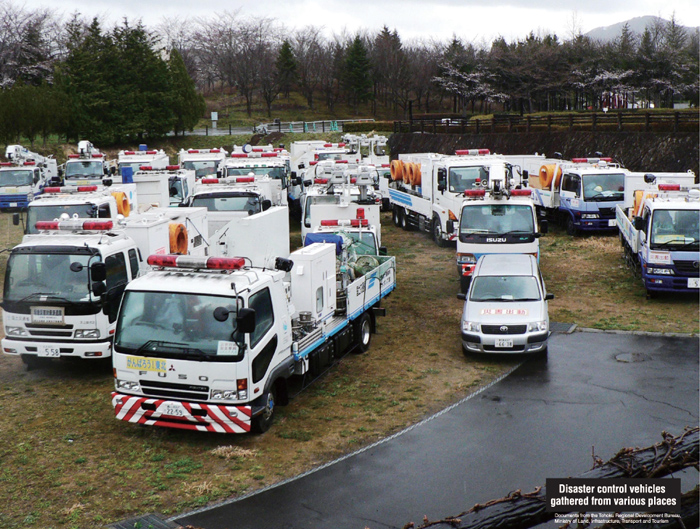
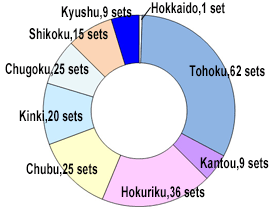
In order to support various activities toward restoration, total 192 disaster response vehicles so far have been dispatched to 27 municipalities (17 cities, 8 towns, and 2 villages) in 3 prefectures, in cooperation with the Regional Bureaus all over Japan. The dispatched disaster response vehicles include pumper trucks, lighting vehicles, mobile command vehicles, standby support vehicles, satellite communication vehicles, and Ku-SAT.
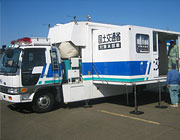 |
Mobile command vehicleA mobile command vehicle provides a working space for information gathering, commanding, evaluating the strategy, and communicating with other organizations as response headquarters on site of the disaster. |
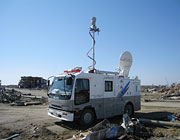 |
Satellite communication vehicleA satellite communication vehicle provides an alternative communication channel when conventional terrestrial telecommunication lines (the network of NTT and mobile phone) are disrupted in disaster or when people need to establish a communication channel with a site of disaster, using communication satellites. People can use this alternative channel at the site of disaster to inform the magnitude of damage, etc. |
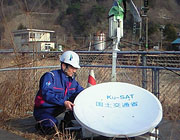 |
Ku-SATA Ku band satellite dish (small satellite image transfer device) helps distribute images and voice at the same time using satellite communication. Its small size and light weight make it portable. |
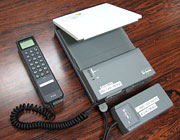 |
Satellite mobile phoneA satellite mobile phone provides an alternative communication channel when conventional terrestrial telecommunication lines (the network of NTT and mobile phone) are disrupted in disaster or when people need to establish a communication channel with a site of disaster, using communication satellites. People can use this alternative channel at the site of disaster to inform the magnitude of damage, etc. |
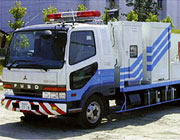 |
Pumper truckA pumper truck drains water fast and effectively from flooded areas primarily in a scene of disaster, such as storms. |
 |
Lighting vehicleA lighting vehicle provides lighting for works in the night at site of disaster. |
Summary of dispatching disaster response units (As of April 15)
| Pumper truck | Iwate Prefecture | Rikuzentakata: | 1 |
|---|---|---|---|
| Miyagi Prefecture | Sendai: | 13 | |
| Ishinomaki: | 25 | ||
| Natori: | 2 | ||
| Higashimatsushima: | 16 | ||
| Tagajo: | 2 | ||
| Shichigahama: | 4 | ||
| Watari: | 19 | ||
| Yamamoto: | 2 | ||
| Kesennuma: | 1 | ||
| Fukushima Prefecture: | 4 | ||
| Soma: | 5 | ||
| Shinchi: | 1 | ||
| Sub Total: | 95 | ||
| Lighting vehicles | Iwate Prefecture | 2 | |
| Rikuzentakata: | 2 | ||
| Miyagi Prefecture | Sendai: | 4 | |
| Ishinomaki: | 8 | ||
| Kakuta: | 1 | ||
| Higashimatsushima: | 7 | ||
| Natori: | 2 | ||
| Yamamoto: | 1 | ||
| Watari: | 9 | ||
| Minamisanriku: | 4 | ||
| Shichigahama: | 4 | ||
| Fukushima Prefecture: | 2 | ||
| Fukushima: | 3 | ||
| Soma: | 2 | ||
| Sub Total: | 51 | ||
| Mobile command vehicle | Iwate Prefecture | 2 | |
| Rikuzentakata: | 1 | ||
| Otsuchi: | 1 | ||
| Miyagi Prefecture | Iwanuma: | 1 | |
| Higashimatsushima: | 1 | ||
| Minamisanriku: | 1 | ||
| Onagawa: | 1 | ||
| Sub Total: | 8 | ||
| Standby support vehicles | Iwate Prefecture | 1 | |
|---|---|---|---|
| Otsuchi: | 1 | ||
| Miyagi Prefecture | Sendai: | 1 | |
| Ishinomaki: | 6 | ||
| Iwanuma: | 1 | ||
| Higashimatsushima: | 2 | ||
| Shichigahama: | 1 | ||
| Minamisanriku: | 1 | ||
| Fukushima Prefecture: | 1 | ||
| Sub Total: | 15 | ||
| Satellite communication vehicle | Iwate Prefecture | 1 | |
| Rikuzentakata: | 1 | ||
| Ofunato: | 1 | ||
| Miyagi Prefecture | Ishinomaki: | 3 | |
| Onagawa: | 1 | ||
| Sub Total: | 7 | ||
| Noda: | 1 | ||
| Tanohata: | 1 | ||
| Miyako: | 1 | ||
| Kamaishi: | 2 | ||
| Ofunato: | 1 | ||
| Yamada: | 1 | ||
| Otsuchi: | 1 | ||
| Ishinomaki: | 4 | ||
| Kesennuma: | 1 | ||
| Yamamoto: | 1 | ||
| Minamisanriku: | 1 | ||
| Iwanuma: | 1 | ||
| Sub Total | 16 | ||
| Total: | 192 | ||
130 out of 190 vehicles were reinforcements called in from the Regional Bureaus all over Japan.
13 disaster response vehicles, mainly sprinkler trucks, were dispatched to the Fukushima Daiichi Nuclear Power Plant as reinforcements (operated under the command of TEPCO).
